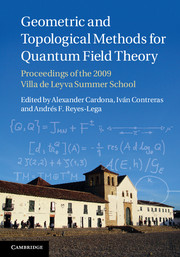 Geometric and Topological Methods for Quantum Field Theory
Geometric and Topological Methods for Quantum Field Theory Book contents
- Frontmatter
- Contents
- List of contributors
- Introduction
- 1 A brief introduction to Dirac manifolds
- 2 Differential geometry of holomorphic vector bundles on a curve
- 3 Paths towards an extension of Chern–Weil calculus to a class of infinite dimensional vector bundles
- 4 Introduction to Feynman integrals
- 5 Iterated integrals in quantum field theory
- 6 Geometric issues in quantum field theory and string theory
- 7 Geometric aspects of the Standard Model and the mysteries of matter
- 8 Absence of singular continuous spectrum for some geometric Laplacians
- 9 Models for formal groupoids
- 10 Elliptic PDEs and smoothness of weakly Einstein metrics of Hölder regularity
- 11 Regularized traces and the index formula for manifolds with boundary
- Index
- References
4 - Introduction to Feynman integrals
Published online by Cambridge University Press: 05 May 2013
- Frontmatter
- Contents
- List of contributors
- Introduction
- 1 A brief introduction to Dirac manifolds
- 2 Differential geometry of holomorphic vector bundles on a curve
- 3 Paths towards an extension of Chern–Weil calculus to a class of infinite dimensional vector bundles
- 4 Introduction to Feynman integrals
- 5 Iterated integrals in quantum field theory
- 6 Geometric issues in quantum field theory and string theory
- 7 Geometric aspects of the Standard Model and the mysteries of matter
- 8 Absence of singular continuous spectrum for some geometric Laplacians
- 9 Models for formal groupoids
- 10 Elliptic PDEs and smoothness of weakly Einstein metrics of Hölder regularity
- 11 Regularized traces and the index formula for manifolds with boundary
- Index
- References
Summary
Abstract
In these lecture notes I will give an introduction to Feynman integrals. In the first part I review the basics of the perturbative expansion in quantum field theories. In the second part I will discuss more advanced topics: mathematical aspects of loop integrals related to periods, shuffle algebras and multiple polylogarithms are covered as well as practical algorithms for evaluating Feynman integrals.
Introduction
In these lecture notes Iwill give an introduction to perturbation theory and Feynman integrals occurring in quantum field theory. But before embarking onto a journey of integration and special function theory, it is worth recalling the motivation for such an effort.
High-energy physics is successfully described by the Standard Model. The term “Standard Model” has become a synonym for a quantum field theory based on the gauge group SU(3) ⊗ SU(2) ⊗ U(1). At high energies all coupling constants are small and perturbation theory is a valuable tool to obtain predictions from the theory. For the Standard Model there are three coupling constants, g1, g2 and g3, corresponding to the gauge groups U(1), SU(2) and SU(3), respectively. As all methods which will be discussed below do not depend on the specific nature of these gauge groups and are even applicable to extensions of the Standard Model (like super-symmetry), I will just talk about a single expansion in a single coupling constant. All observable quantities are taken as a power series expansion in the coupling constant, and calculated order by order in perturbation theory.
- Type
- Chapter
- Information
- Geometric and Topological Methods for Quantum Field TheoryProceedings of the 2009 Villa de Leyva Summer School, pp. 144 - 187Publisher: Cambridge University PressPrint publication year: 2013
References
- 4
- Cited by


